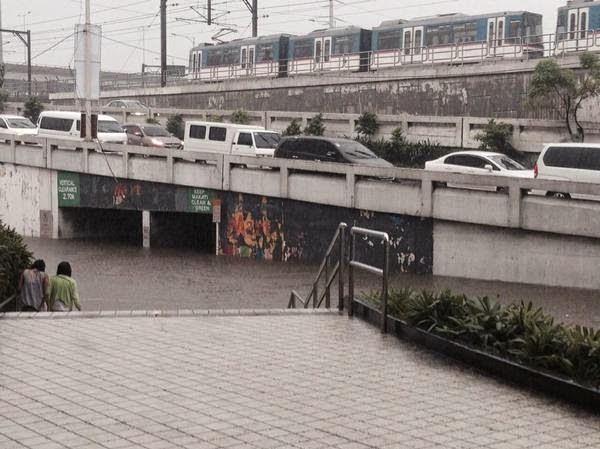- I was trying to get to Ortigas last week but had only hit Guadalupe (not even the bridge) after two hours. Google Maps says that distance should only have taken twelve minutes, and even if that is under the most optimistic of trafffic circumstances, it really shouldn't have - and in the past hasn't - taken 120 minutes. I had to cancel my meeting and turn back, spending another hour on the road before I got home.
- The next day my sister and I were in Toby's Estate in Salcedo Village. We called our car to come get us from our house, which is also in Makati. It took an hour to pick us up and another 45 mintues to get home. All in Makati!
- It took my younger brother, who studies in Ateneo, an hour to get from school to The Fort, and two more hours in The Fort to turn on to McKinley.
- This is from my own experience; I can only imagine the commuters' side of the story.
Some pretty pathetic pictures from news media pages:
 |
| Ayala Ave. - Makati Ave. intersection (via) |
 |
| Pasong Tamo tunnel flooded as of 3:40pm yesterday. (via) |
 |
| EDSA last night (via) |
 |
| "Top photo was taken at 5:11pm. Bottom photo was taken at 6:47pm. Same spot on SLEX-Nichols Bridge." (via) |
Only short-term solutions being proposed. “We have to give priority to the public utility vehicles since private cars can find other roads apart from EDSA,” according to an LTFRB board member (Philstar), a scheme that would prevent private cars from driving on EDSA between 6am and 9am. This might help in the morings but completely disregards the worst traffic of the day - rush hour after 5pm. It also implies that there isn't enough room for both private and public vehicles on EDSA which isn't the case. The problem is that buses and jeeps stop anywhere and take their time loading passengers even if they are blocking traffic. EDSA is both highway and loading dock.
There are other angles to the problem:
- Do we have the right roads to accommodate the number of people who move around in Manila everyday?
- Is there adequate public transportation? Do these systems encourage a commuter culture vs. public vehicles?
- Are public transporation drivers properly educated about being a good citizen on the road? Are they equipped with the proper protocol and guidelines for not causing traffic? Are they incentivized enough so that they can think not only about themselves but for the good of the entire community on the road?
- Does the city accommodate walkers and bikers with sidewalks and bike lanes?
- Do we have enough urban centers in the country, enough to depopulate Manila?
- Are zoning laws being properly implemented? There are no businesses or buildings on major freeways in other countries, with space for vehicles to properly exit major highways to enter businesses or business districts (unlike Megamall situation which uses EDSA as their driveway, with more buildings added practically on the highway every few years).
- What causes flooding? What are the streets that flood fastest / most frequently?
It can seem pretty hopeless. What is one to do in the face of horrendous late-afternoon to evening to nighttime traffic? Leave work early? Not work at all?
We need design thinking! To come up with long-term solutions. Band-aids won't fix these problems. Haven't we already done the yellow lane and the coding scheme? But new cars and the unsupervised public transporation build on top of that and they are soon inadequate. We need to isolate the root causes of flooding and traffic in order to put real solutions in place. We need design thinking to find and address the problems on different layers and create a system of solutions that involve government officials, businesses, public transporation operators, private vehicle owners, commuters, pedestrians, traffic enforcers.
There is an answer to this; other cities have done it. There are cities where people don't even want to buy cars because it's so much more convenient to commute. What we don't know is if the right confluence of vision, strategy and implementation will ever come together in the hands of the lovely people in government to make Manila a city we can be happy to move around in.

No comments
Post a Comment